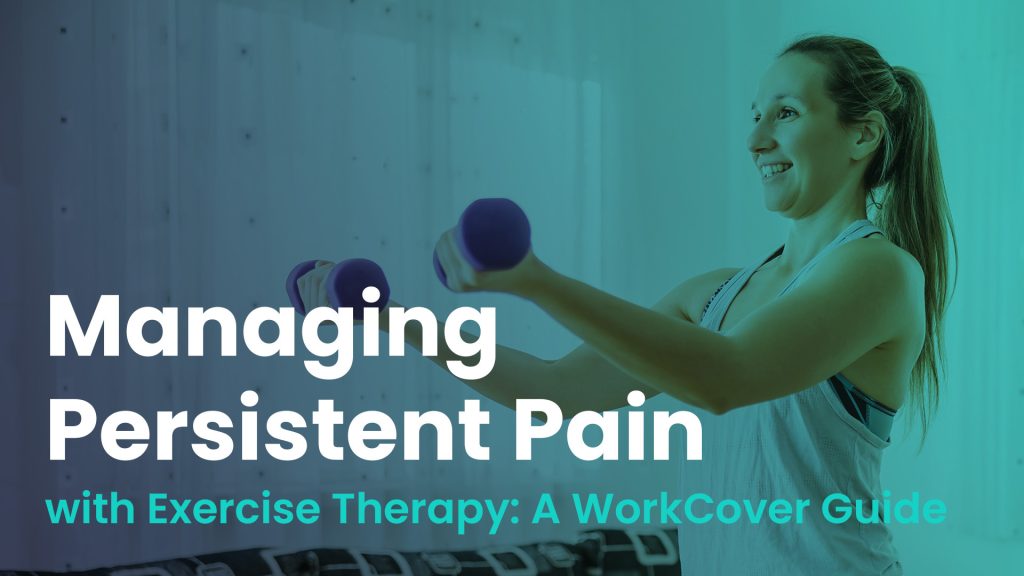
Persistent pain is a common challenge for many workers recovering from workplace injuries. It can significantly impact quality of life and prolong the return-to-work process. Exercise therapy offers a practical, non-invasive way to manage chronic pain and enhance recovery. This blog explains how exercise therapy can help manage persistent pain and how to access these services through WorkCover.
Understanding Persistent Pain
Persistent pain is pain that lasts longer than the usual course of healing, often beyond three months. It can be caused by:
- Musculoskeletal Injuries: Injuries to muscles, joints, and ligaments are common causes of chronic pain.
- Nerve Damage: Injuries affecting nerves can lead to neuropathic pain.
- Repetitive Strain Injuries: Caused by repetitive motion or overuse, leading to ongoing pain and discomfort.
Role of Exercise in Managing Chronic Pain
Exercise therapy plays a crucial role in managing persistent pain by:
- Reducing Pain Sensitivity: Regular exercise can help desensitise pain receptors and reduce the perception of pain.
- Improving Physical Function: Strengthening muscles and improving flexibility can help support injured areas, reducing strain and pain.
- Enhancing Mental Health: Exercise releases endorphins, which help improve mood and reduce the psychological impact of chronic pain.
- Preventing Deconditioning: Staying active helps prevent muscle atrophy and joint stiffness, which can exacerbate pain.
For more information on how we can help you, click here.
Types of Exercises for Pain Management
Different exercises can help manage persistent pain:
- Low-Impact Aerobic Exercises: Activities like walking, cycling, or swimming improve cardiovascular health without placing too much strain on joints.
- Strength Training: Builds muscle strength, supporting injured areas and reducing pain.
- Stretching and Flexibility Exercises: Improve range of motion and reduce stiffness, which can alleviate pain.
- Mind-Body Exercises: Activities like yoga and Pilates combine physical exercise with relaxation techniques, helping manage pain more effectively.
Psychological Benefits of Exercise
In addition to physical benefits, exercise offers significant psychological advantages for those dealing with chronic pain:
- Reduces Anxiety and Depression: Exercise can help improve mood and reduce the mental burden of living with persistent pain.
- Improves Sleep Quality: Regular physical activity can help improve sleep, which is often disrupted by chronic pain.
Success Stories
Consider Tom, an injured worker who struggled with persistent back pain after a workplace accident. Through a tailored exercise program focusing on core strengthening and flexibility, Tom managed to significantly reduce his pain and return to work sooner than expected. Similarly, Lisa found relief from chronic neck pain with a combination of aerobic exercise and strength training, improving her quality of life.
Navigating WorkCover for Pain Management Programs
To access exercise therapy for pain management through WorkCover:
- Report Your Injury and Pain: Ensure your injury and any ongoing pain are reported to your employer and WorkCover.
- Seek a Medical Assessment: A healthcare provider will assess your pain and recommend treatments, including exercise therapy.
- Find an Approved Provider: Choose a WorkCover-registered exercise physiologist to guide your rehabilitation program.
- Follow Your Pain Management Plan: Commit to the prescribed exercise routine and attend follow-up appointments to track progress and make necessary adjustments.
The Australia Pain Society has a multitude of resources that can help you with pain management.
Exercise therapy is an effective, evidence-based approach to managing persistent pain for injured workers. By improving physical function and reducing pain perception, exercise helps injured workers regain control over their recovery and return to work confidently.
Struggling with persistent pain after a workplace injury? Contact us today to learn how our exercise therapy programs can help you manage pain and get back to living your life fully.
